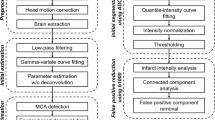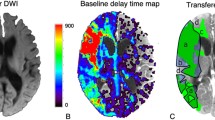Abstract
Purpose
Thrombolytic therapy in patients with acute ischemic stroke is contraindicated when the infarction core exceeds a given threshold. To date, there are no standardized guidelines for computed tomography infarction core assessment. Current practice involves use of thresholding methods, where the results are further adjusted by an experienced physician. An automated method for infarction core delineation and volume measurement was developed and tested.
Materials and methods
CT postprocessing software was developed for analysis of whole brain perfused blood volume (PBV) and cerebral blood volume (CBV) maps. The program was designed for potential use with mean transit time (MTT) or cerebral blood flow (CBF) maps. The proposed method was tested on a set of 12 patients on both PBV and CBV maps with whole brain coverage by comparison with the results of a simple thresholding method and with manually marked findings provided by two independent physicians.
Results
The proposed method produced a marked infarct core volume corresponding to 53 % of the manually delineated volumes. The simple thresholding method with the optimal threshold, using the same dataset, marked 15\(\times \) larger volume compared to the volume delineated by physicians.
Conclusion
An automated infarction core segmentation method based on local neighborhood features was developed and tested, demonstrating its utility in distinguishing between infarcted and non-infarcted areas, as well as reduction in the number of false positives and volume error.







Similar content being viewed by others
References
Abramoff MD, Magalhaes PJ, Ram SJ (2004) Image processing with ImageJ. Biophotonics Int 11:36–42
Bidgood WD, Horii SC (1992) Introduction to the ACR-NEMA DICOM standard. Radiographics 12(2):345–355
Bivard A, McElduff P, Spratt N, Levi C, Parsons M (2011) Defining the extent of irreversible brain ischemia using perfusion computed tomography. Cerebrovasc Dis 31:238–245. doi:10.1159/000321897
Campbell BC, Christensen S, Levi CR, Desmond PM, Donnan GA, Davis SM, Parsons MW (2011) Cerebral blood flow is the optimal ct perfusion parameter for assessing infarct core. Stroke 42(12):3435–3440. doi:10.1161/STROKEAHA.111.618355
Campbell BC, Christensen S, Levi CR, Desmond PM, Donnan GA, Davis SM, Parsons MW (2012) Comparison of computed tomography perfusion and magnetic resonance imaging perfusion-diffusion mismatch in ischemic stroke. Stroke 43(10):2648–2653. doi:10.1161/STROKEAHA.112.660548
Grigaitis D, Bartkute V, Sakalauskas L (2007) An optimization of system for automatic recognition of ischemic stroke areas in computed tomography images. Informatica 18(4):603–614
Hamberg LM, Hunter GJ, Kierstead D, Lo EH, Wolf GL (1996) Measurement of cerebral blood volume with subtraction three-dimensional functional CT. Am J Neuroradiol 17(10):1861–1869
Ibanez L, Schroeder W, Ng L, Cates J (2003) The ITK software guide, 1st edn. Kitware, Inc. ISBN 1-930934-10-6, http://www.itk.org/ItkSoftwareGuide.pdf
Kamalian S, Kamalian S, Maas MB, Goldmacher GV, Payabvash S, Akbar A, Schaefer PW, Furie KL, Gonzalez RG, Lev MH (2011) CT cerebral blood flow maps optimally correlate with admission diffusion-weighted imaging in acute stroke but thresholds vary by postprocessing platform. Stroke 42(7):1923–1928. doi:10.1161/STROKEAHA.110.610618
Lopez AD, Mathers CD, Ezzati M, Jamison DT, Murray CJ (2006) Global and regional burden of disease and risk factors, 2001: systematic analysis of population health data. Lancet 367(9524):1747–1757. doi:10.1016/S0140-6736(06)68770-9
Maule P, Kleckova J, Rohan V, Tupy R (2012) Automated infarction core delineation. In: The seventh international multi-conference on computing in the global information technology (ICCGI 2012) vol 1, pp 127–130
Ourselin S, Roche A, Prima S, Ayache N (2000) Block matching: a general framework to improve robustness of rigid registration of medical images. In: Delp S, DiGoia A, Jaramaz B (eds) Medical image computing and computer-assisted intervention—MICCAI 2000 (Lecture Notes in Computer Science), vol 1935. Springer, Berlin/Heidelberg, p CH373. doi:10.1007/978-3-540-40899-4_57
Perona P, Malik J (1990) Scale-space and edge detection using anisotropic diffusion. IEEE Trans Pattern Anal Mach Intell 12(7):629–639. doi:10.1109/34.56205
Sabatini U, Celsis P, Viallard G, Rascol A, Marc-Vergnes J (1991) Quantitative assessment of cerebral blood volume by single-photon emission computed tomography. Stroke 22(3):324–330. doi:10.1161/01.STR.22.3.324
Schaefer PW, Roccatagliata L, Ledezma C, Hoh B, Schwamm LH, Koroshetz W, Gonzalez RG, Lev MH (2006) First-pass quantitative CT perfusion identifies thresholds for salvageable penumbra in acute stroke patients treated with intra-arterial therapy. AJNR Am J Neuroradiol 27(1):20–5
Srinivasan A, Goyal M, Azri FA, Lum C (2006) State-of-the-art imaging of acute stroke1. Radiographics 26(suppl 1):S75–S95. doi:10.1148/rg.26si065501
Toussaint N, christophe Souplet J, Fillard P (2007) Medinria: medical image navigation and research tool by INRIA. In: Proceedings of MICCAI workshop on interaction in medical image analysis and visualization
Usinskas A, Navakauskas D (2003) Segmentation of ischemic stroke in CT images of human brain. Technical Report LiTH-ISY-R-2500, Department of Electrical Engineering, Linköping University, SE-581 83 Linköping, Sweden
Wintermark M, Flanders AE, Velthuis B, Meuli R, van Leeuwen M, Goldsher D, Pineda C, Serena J, Waaijer A, Anderson J, Nesbit G, Gabriely I, Medina V, Quiles A, Pohlman S, Quist M, Schnyder P, Bogousslavsky J, Dillon WP, Pedraza S (2006) Perfusion-CT assessment of infarct core and penumbra. Stroke 37(4):979–985. doi:10.1161/01.STR.0000209238.61459.39
Acknowledgments
The research was supported by a grant from the Grant Agency of the Czech Republic—Microstructure-oriented hierarchical modeling of brain perfusion for CT-based cerebral blood flow evaluation, no. 106/09/0740.
Conflict of interest
None.
Author information
Authors and Affiliations
Corresponding author
Rights and permissions
About this article
Cite this article
Maule, P., Klečková, J., Rohan, V. et al. Automated infarction core delineation using cerebral and perfused blood volume maps. Int J CARS 8, 787–797 (2013). https://doi.org/10.1007/s11548-013-0815-9
Received:
Accepted:
Published:
Issue Date:
DOI: https://doi.org/10.1007/s11548-013-0815-9




